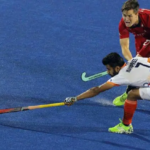The 2015 Hawke’s Bay Cup was held from April 11 to April 19, 2015, at the Hawke’s Bay Sports Park in Hastings, New Zealand. This prestigious invitational tournament featured eight top international teams: Australia, New Zealand, China, South Korea, the United States, Japan, Argentina, and India. For the Indian women’s team, the event was a valuable opportunity to test their skills against some of the world’s best and to gain critical experience on the global stage. Despite facing tough opposition, the Indian team showed resilience and flashes of promise throughout the competition.
Match Recap
India vs China
(Result: India 1–2 China, 11 April 2015)
India began their campaign against China in their opening pool match. The Indian team displayed energy and intent, working hard to match China’s pace and tactical discipline. Rani Rampal scored India’s lone goal, capitalizing on a rare opportunity in front of the Chinese goal. Despite their efforts, India conceded twice and lost 1–2, but the match highlighted the team’s fighting spirit and ability to challenge higher-ranked opponents.
India vs USA
(Result: India 2–4 USA, 12 April 2015)
In their second pool match, India faced the United States. The Indian women started brightly, taking an early lead and showing attacking flair. Vandana Katariya and Rani Rampal were on target, giving India hope of a positive result. However, the US team responded strongly, scoring four goals to turn the match in their favor. India’s defense struggled to contain the American forwards, and the contest ended 2–4 despite India’s spirited efforts in attack.
India vs Australia
(Result: India 0–0 Australia, 14 April 2015)
In their final pool match of the Hawke’s Bay Cup 2015, India faced a formidable Australian side. The Indian team put up a disciplined and resilient performance, successfully holding the world No. 2 team to a goalless draw. Throughout the match, India’s defense remained solid, effectively neutralizing Australia’s attacking threats and maintaining composure under pressure. The midfielders worked tirelessly to disrupt Australian play and create counter-attacking opportunities. Despite several promising forays into the Australian circle, India was unable to convert chances into goals. This 0–0 stalemate was a significant result for India, reflecting their growth and ability to compete against top-tier teams on the international stage.
Quarterfinal: India vs New Zealand
(Result: India 1–4 New Zealand, 16 April 2015)
In the quarterfinals, India faced hosts New Zealand. The Indian team started with determination, but the home side’s relentless attack soon took control. India managed to score a consolation goal through Lilima Minz, but New Zealand’s superior finishing saw them win 4–1. The Indian players continued to fight till the end, showing resilience even as the scoreboard tilted heavily against them.
7th-8th Place Classification: India vs Japan
(Result: India 3–2 Japan, 19 April 2015)
India’s final match was the 7th-8th place classification against Japan. Japan took an early lead and doubled it shortly after, putting India under pressure. India responded by attacking more aggressively, and in the 28th minute Sushila Pukhrambam scored to reduce the deficit. After a goalless third quarter, India struck twice in the final fifteen minutes, scoring two consecutive goals within three minutes—to seal a 3–2 comeback victory. This win secured seventh place for India and was a testament to the team’s perseverance and ability to bounce back after a tough campaign.
Semifinals and Finals
India did not qualify for the semifinals, as they were eliminated in the quarterfinal stage. The semifinals were contested by Australia, New Zealand, China, and South Korea. Australia won the title for the first time, defeating New Zealand 3–2 in a thrilling final, while China claimed third place by beating South Korea 3–1.
The final standings for the top five teams were:
- Australia
- New Zealand
- China
- South Korea
- United States
India finished seventh, ahead of Japan, after their victory in the classification match.
Summary and Vision Ahead
The Hawke’s Bay Cup 2015 was a challenging tournament for the Indian women’s hockey team, but it offered valuable lessons and moments of promise. India’s ability to score against strong opponents and their fighting spirit in the face of adversity were positives to build on. However, defensive lapses and inconsistency against higher-ranked teams highlighted areas for improvement. Going forward, the Indian women’s team needs to focus on tactical discipline, sharper finishing, and greater consistency to compete with the world’s best. With continued exposure to top-tier competition and a commitment to development, the future holds promise for Indian women’s hockey.

